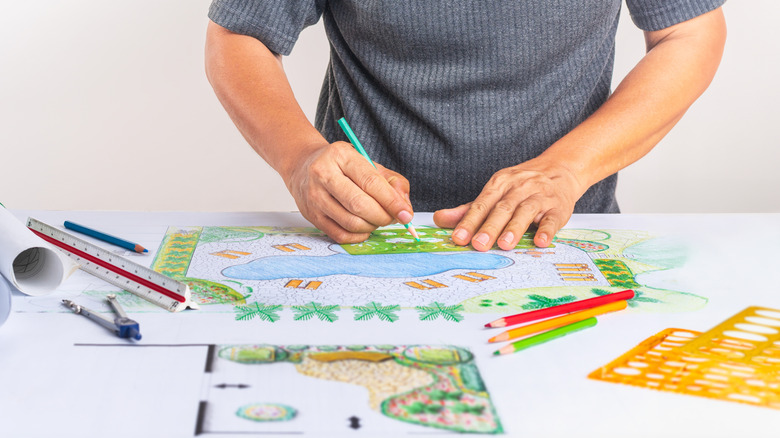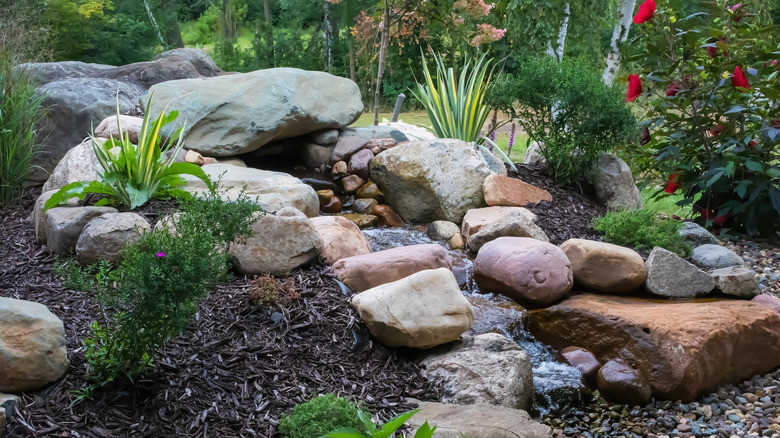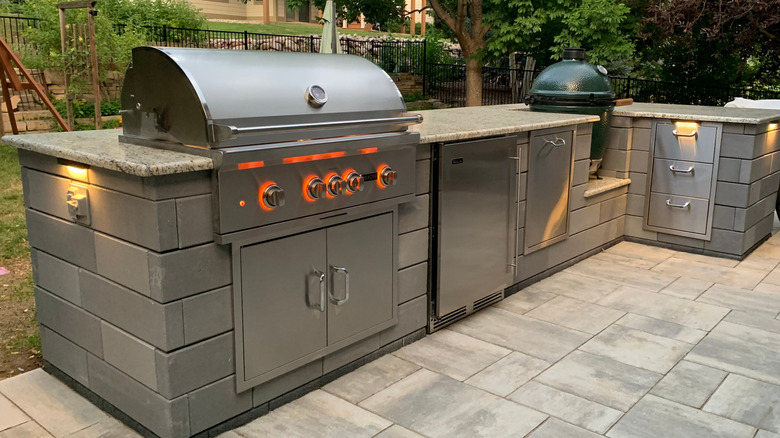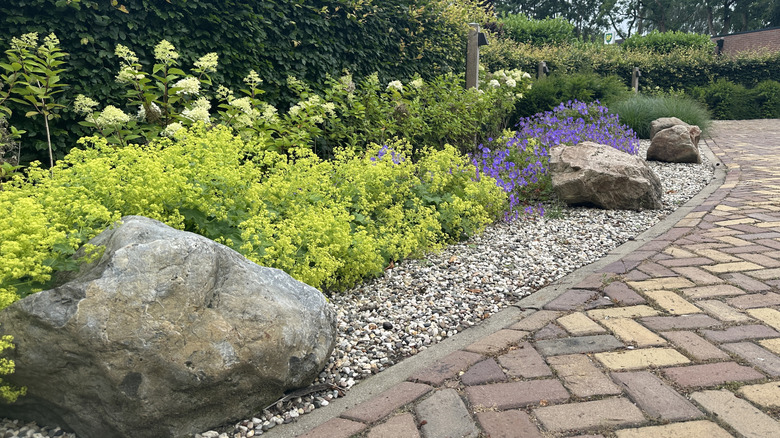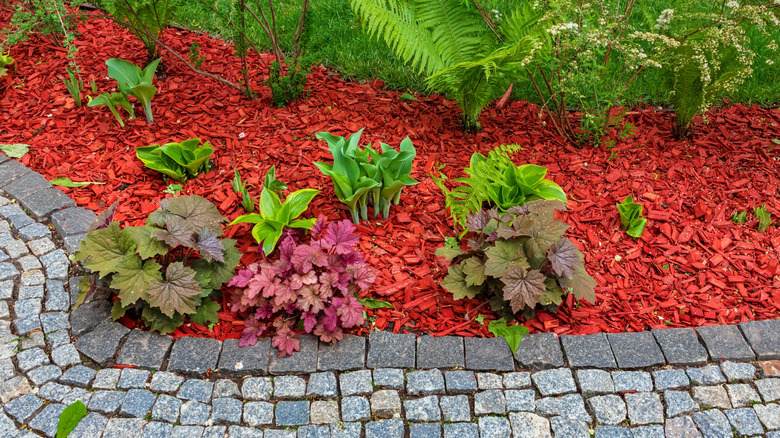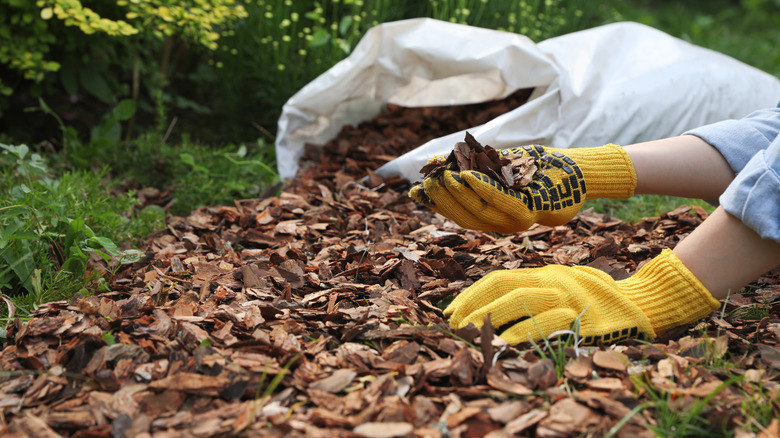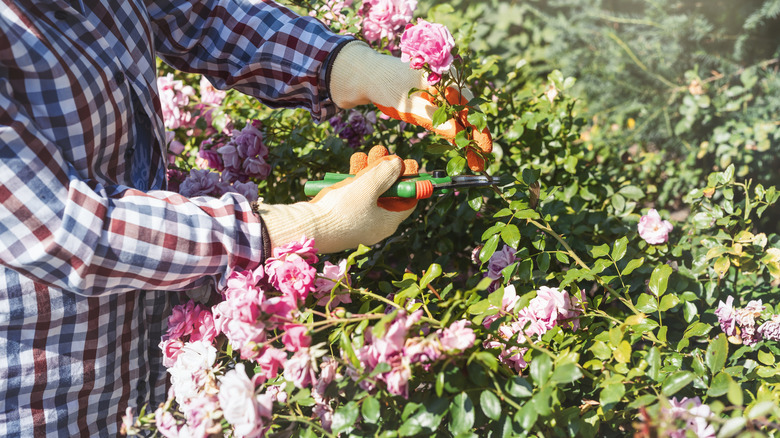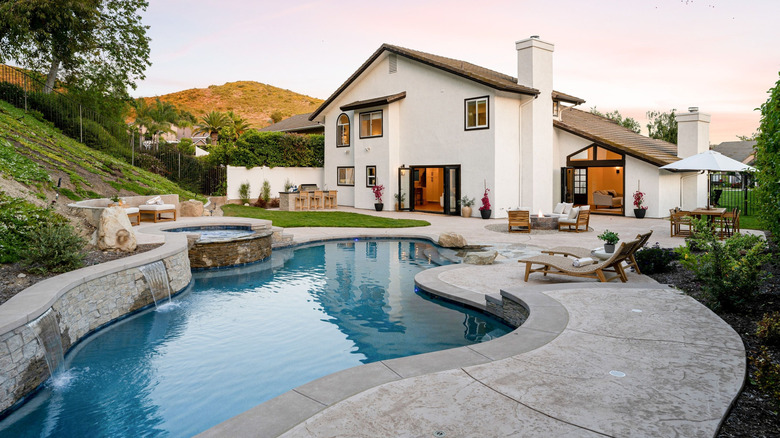8 Landscaping Upgrades That Are A Big Waste Of Money
We may receive a commission on purchases made from links.
If you love spending time outdoors and hosting summer get-togethers, then you likely put a lot of thought into your backyard's landscaping. After all, you want to enjoy your time in the space and create a welcoming atmosphere for friends and family. Because of this, there are several backyard upgrades that you'll likely decide are worth the cost due to how much more enjoyable they can make the space. However, while some enhancements are great investments, that is not the case for many other pricey projects.
In fact, there are some landscaping upgrades that you might end up regretting after the fact. We spoke with four professional landscape and design experts to learn more about which upgrades you should think twice about to save yourself hassles, headaches, and unnecessary expenses. Ahead, you can learn more by reading through the advice that each of these professionals shared exclusively with House Digest.
Water features will require a lot of potentially expensive maintenance over the years
Installing a fountain, pond, or even a little stream in your backyard might sound like a good idea. You'll be able to hear the flowing water, provide a drinking source to attract birds, and of course, add a dramatic effect to your outdoor space. However, adding a water feature might not be as beneficial to your landscaping and overall yard as you might think. When speaking exclusively with House Digest, Tom Smith, the owner of Desert Designer Landscape and Development, said, "People like the idea of having a water feature because they believe it will add some calmness or a unique focal point to their yard. However, what most people do not consider is the cost of upkeep and the effort it takes to maintain water features."
Smith explains that the pumps that facilitate the flow of water must be cleaned frequently to prevent them from getting clogged. Sometimes, these clogs can be cleared, while other times the pump itself may become completely non-functional, making it necessary to purchase a new and potentially expensive pump. "If you aren't willing to pay for the upkeep of a water feature, then just don't install one. I suggest speaking with a professional and getting an estimated cost on maintenance and what that maintenance is before installing any style of water feature in your yard," says Smith. For a lower-cost water feature, look for options like Alpine Corporation's Waterfall Fountain that are easy to maintain and simple to set up.
Unless you're going to spend all summer cooking out, skip the built-in BBQ area
A built-in BBQ patio area is the stuff dreams are made of for many home grill masters. When you go outside to fire up the grill, all you'll need to bring out with you is your burgers, dogs, and any other meat that you're going to cook. Everything is stored in the outdoor drawers, so no more juggling a huge stack of tools or running back inside because you forgot the spatula. Plus, a built-in grill area gives your outdoor cooking space a finished look that screams custom backyard.
However, as incredible as this may sound, Smith shares that a built-in BBQ area is going to turn out to be a big waste of money for homeowners who aren't avid grillers. "If you aren't going to use it, don't buy it. Yes, it looks good on your patio but why waste a thousand dollars on a grill and other tools when you aren't going to use the thing," he says.
Just because splurging for the ultimate grilling setup is unlikely to be worth it for every reader, don't worry. There are other great ways to get your occasional BBQ on. Instead, consider some more affordable outdoor grill station ideas. Look at an option like the Monument Grills Stainless Steel Cabinet Style Model that has some functional storage. You could also add prep space as well as spots to stash tools and other essentials with a Rolling Outdoor Grill Cart. Not only are these options more affordable than a built-in BBQ, but they are portable, making your outdoor cooking setup more flexible.
Large landscaping rocks cost more than the value they'll add to the yard
As you're thinking about how you want to landscape your backyard, you might be contemplating adding some large landscaping rocks. Some people choose to use these large stones to create stairways, set up a rustic seating area, or even create waterfalls and other features. However, while some of these ideas might sound appealing, Tom Smith recommends against using large landscaping rocks to achieve them. "Stone costs money, and in today's world, it costs a lot. You can get by designing your yard without using large stones or bringing in big rocks to your yard," he says. Moreover, Smith advises against adding large stones as a focal point for a small yard, saying, "The size of them will only make your yard feel smaller."
Now, just because large landscaping rocks probably aren't worth the cost, that doesn't mean you should stay away from all stones or rocks for your space. Rocks and stones can definitely help enhance your landscaping, but there are less expensive options that are probably a better choice. Smith says, " If you want to save money, you can create areas with pavers and other stonework that is easily bought at a local hardware store."
Dyed mulches will fade quicker than you might think
Laying dyed mulch along your flower beds and the bases of the trees in your yard might sound appealing. Vibrant colors, such as red, cedar, and gold, could serve to enhance the aesthetics of your lawn, while the mulch also retains moisture to support plant growth. However, there are a few reasons you might want to rethink this potential landscaping upgrade. During an exclusive interview, Ward Dilmore, the founder and head landscape designer at Petrus Landscaping, told House Digest, "Dyed mulch is often made with large wood chips that will lose their color after a season or two which can become very unsightly in gardens over time." This means that you'll not only be making a larger initial investment (dyed mulch typically costs more per cubic yard than natural options), but that you'll have to start all over again with new mulch in a few years if you want to maintain the look.
Beyond the questionable impact on your yard's aesthetics, there are other concerns around the use of dyed mulch. While the dye itself may not be toxic, you still should avoid laying the mulch in a vegetable garden. This is because recycled wood is typically shredded to make colored mulches. You can't be certain whether any of this reclaimed wood has been treated or used with any toxic chemicals, which could then leach into the garden soil.
Applying too much mulch may cause serious problem
Choosing a colored product isn't the only mulching upgrade that could prove to be a big waste of money. Joshua Faas, the owner and lead designer at Paperbark Design Studio LLC, also says that over-mulching will prove to be a big waste of money. "By not allowing the previous year's mulch to break down, you're just paying to bury good material," he shared when speaking exclusively with House Digest. Instead, he notes that a standard top-dressing or giving a little extra attention to certain areas that have seen too much erosion is all that you'll need to get your yard and garden looking their best for the season.
However, this can prove to be more than just a financial waste. According to Faas, over-mulching has the potential to create other potential hazards. It could threaten the vegetation in your yard, lead to added frustrations, or even cost you a significant amount of money and work to counteract the damage. He explains, "Things like water runoff, shallow rooting, and root suffocation can all happen when too much mulch is used, and water can't penetrate to the soil below."
Don't waste your money on an instant garden that may actually threaten the health of the plants it holds
Whether you're planning on hosting an outdoor gathering in the near future or simply don't want to stress about making sure your garden is vibrant and beautiful, you might consider hiring a professional. While leaving this task to an experienced landscaper can certainly help you turn your dreams into reality, you should do some research before trusting just anyone. "There are some companies out there where more means better, and sometimes that could not be further from the truth," says Faas. These companies may add dense plantings throughout your garden beds to make them look lush and full.
However, while this might look nice initially, Faas cautions that such an approach will turn into a waste of money because of all the problems you may soon be left with. Plants need space to grow in order to ensure their roots have access to all the water and nutrients they need and to provide adequate air circulation. He explains, "Overcrowding can waste money each year as plants will overtake each other more and more as they mature." This is an often overlooked mistake that's making your garden beds look bad. To salvage it, you'll end up having to pull some of your investment out to keep your garden looking its best. Instead, make sure plants have their recommended spacing so they can mature well, and try to be patient as your beds fill out over a few seasons. If you feel the need to fill any gaps, use container gardens that can be moved or plant annuals that won't be a factor the following year.
Avoid spending money on high-maintenance plants that you won't be able to give the attention they need
According to Rafi Friedman, the CEO of Coastal Luxury Outdoors, purchasing high-maintenance plants for a yard will likely prove to be a mistake for many people. Just as you should avoid high-maintenance houseplants if you live a busy life, you'll want to be purposeful in picking out the plants to add to a backyard. When speaking exclusively with House Digest, Friedman said, "If you're a dedicated gardener, by all means, get those orchids or rose bushes or that tree that isn't quite right for your climate zone."
Otherwise, Friedman says, "Your landscaping plants should be able to take care of themselves in a pinch." This way, if something goes wrong and you aren't available to take care of your plants for a short period, they will have a much better chance at survival. Some low-maintenance flowering plants to consider include irises, zinnias, and lavender. However, steer clear of higher-maintenance ivy and azaleas if you're looking to keep your stress levels down.
Unless used regularly, a pool or hot tub will likely be a waste of money
Pools and hot tubs are pricey additions to a backyard. An in-ground pool can cost between $40,000 and $120,000, and a new hot tub could easily work out to be about $6,000. For some who will spend their summers entertaining and splashing around, this investment may be well worth it. However, Friedman cautions that these expensive upgrades will not prove to be worth it for many others and that you might actually regret installing that in-ground pool or hot tub. "Pools and hot tubs take up a lot of space in your yard, they require regular maintenance and upkeep, and they're going to increase your energy bills," he says.
Consider putting your money to better use with a landscaping upgrade you'll actually use, whether that's a new patio or deck, a fire pit, or some outdoor lighting. You can still get your pool time in during the summer. But, as Friedman puts it, "If you aren't going to regularly use a pool or hot tub, you're much better off simply skipping these upgrades and going to a public pool or health club for your swimming."
